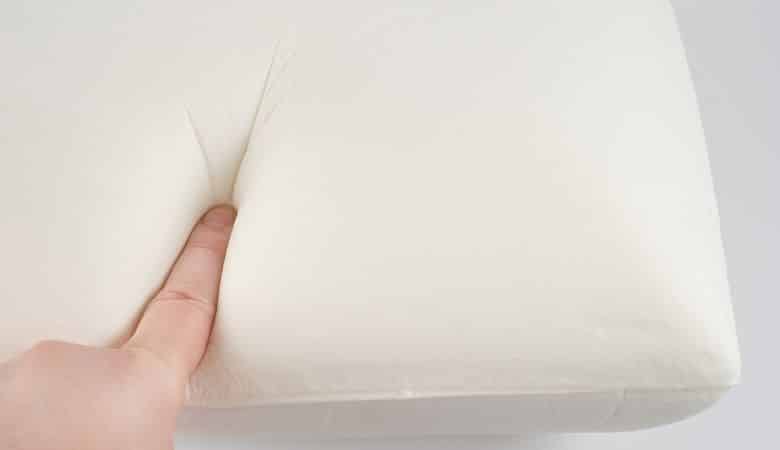This post is part of the complete memory foam pillow buyers guide
One of the determining factors of a good night’s sleep is having the right pillow. A pillow provides the comfort you need to fall asleep and offers head and neck support while ensuring your cervical curvature is aligned.
When choosing the right pillow, many people opt for memory foam pillows because of their contouring nature and incredible comfort.
But are memory foam pillows better than regular pillows? Memory foam pillows are better than regular pillows if you need good support to avoid and/or relieve back, shoulder or neck pain. Memory foam are also hypoallergenic, which are good if you struggle with allegies and/or asthma.
There are many other advantages and disadvantages of using memory foam pillows that you should take into consideration before deciding to purchase one instead of a more regular pillow. So, read on to learn more about these pros and cons.
What are Memory Foam Pillows?

Memory foam is a polymer known as polyurethane. This type of bedding material softens due to pressure and heat from your body. This means it contours around your head, neck, and body, providing optimum comfort and support.
While memory foam pillows are a tad more expensive than regular pillows, the level of comfort and support memory foam provides is completely worth it. Memory foam pillows are designed exquisitely to improve your quality of sleep and alleviate any pain that occurs due to the misalignment of your cervical curve.
Advantages of Memory Foam Pillows
Memory foam pillows have many advantages over regular pillows. Some of them include;
1. Superior Support
The biggest selling point memory foam pillows have is that they mold to fit each person’s body by responding to pressure and body heat. This means your head and neck are supported according to their needs, and this retains the natural curvature of your body and spine.
As you toss through the night, the pillow conforms to your positions and gives you the necessary support as needed. Unlike regular pillows where you have to adjust or plop up the pillow when you turn, memory foam adjusts and adapts quickly to your new position and sleeping posture.
2. Durability
Still on the issue of conforming and contouring, memory foam pillows go back to their original shape and form once you get up. The foam is resilient, strong, and will last a long time without losing any of its beneficial properties. If you have used regular pillows in the past, you will appreciate the fact that memory foam pillows don’t turn flat even after several years of use.
3. Hypoallergenic
Memory foam pillows are manufactured using hypoallergenic materials. They are especially recommended for asthmatic people because they prevent the growth of bacteria and allergens.
4. Relieves back, shoulder and neck pain

Memory foam pillows provide support and keep your spine aligned throughout the night. This also keeps your neck, head, and shoulder in the proper position, alleviating any tension or pain.
People suffering from chronic neck, shoulder and back pain benefit significantly from using memory foam pillows. Sometimes the pain could be from the bad posture in the office and the car or strenuous activity, but proper alignment in your sleep helps restore your body to normal.
5. Prevents Snoring
According to Nature’s Sleep, most pillows make your head tilt upwards and close off the airway. The result of this is snoring unless you sleep on your side. Thankfully, memory foam pillows allow your head to remain aligned with your neck and spine, so your air passage stays open, alleviating snoring.
6. Relief from Pressure Points
Most people know the benefits of memory foam mattresses in relieving pressure points. This occurs because the mattress distributes your weight all over. Similarly, these pillows pillows distribute your weight all over your head so that you won’t suffer from neck pain and stiffness. A combination of memory foam mattress and pillow is the perfect remedy against pressure points that occur because of putting too much weight on specific areas of your body.
7. Therapeutic Orthopaedic Option for Neck Pain
The conforming nature of memory foam helps relieve acute or severe neck and head pain caused by medical conditions. Examples of these conditions include arthritis, degenerative spinal conditions, and disc disease.
8. Smoothness
Last but not least, memory foam is a consistent substance without annoying lumps. Even after years of use, the pillow remains as smooth and as firm as ever, which increases your comfort.
Disadvantages of Memory Foam Pillows
As good as these pillows are, they are not without their drawbacks. These can range from overheating to chemical sensitivities, depending on the manufacturer and type of memory foam. Other disadvantages include;
1. Chemical Off-gassing
Chemical off-gassing occurs as a result of the manufacturing process of the chemicals used to make memory foam. Memory foam pillows are mostly wrapped in plastic at the end of production, and this chemical smell can get trapped inside until you unwrap the pillow after buying.
More often than not, you will notice a pungent chemical odor during the first days of using a memory foam pillow. Fortunately, the chemical smell dissipates within a few days to a week, unless you have a high sense of smell.
Until recently, the chemical smell was the least of your worries, as those chemicals were deemed poisonous and even carcinogens. However, manufacturers have stopped using toxic chemicals in the manufacturing of memory foam.
2. Overheating
Memory foam is designed to be very sensitive to temperature changes, including your body heat. This means the pillow is bound to get hot and retain the heat the more your body produces heat. Not all foam pillows are created equal, though.
Some pillows are made of shredded memory foam, which allows better airflow and maintains a cool environment. Be sure to check for information on breathability before buying a memory foam pillow, as it can get quite hot and uncomfortable.
3. Climate Affects the Pillows Firmness

As noted earlier, memory foam is greatly affected by temperature, and this includes external temperature. So if it’s a scorching day, the pillow can get quite soft and hot. Similarly, the pillow will become too firm if it’s freezing outside, which could mean you need to warm it up before you sleep.
4. Heaviness
Because memory foam pillows are made to be firm and compact, they can be a lot heavier than their down or fiber counterparts. This is only a problem if you carry the pillow, but it won’t affect you if you leave it on the bed.
5. Not Suitable for All Sleeping Positions
Memory foam pillows are excellent for back sleepers as they offer the best back and neck support while aligning your spine. However, if you are a front or side sleeper, the support may be too rigid for you, and front sleepers find it difficult to breathe through the contouring.
6. Cost
Of course, we wouldn’t end the drawbacks without mentioning the high cost of these pillows. While you can get a regular pillow for under $10, an ordinary memory foam pillow will set you back at least $30. This is not the most expensive pillow, though, some pillows such as latex latex pillows cost way more than that.
Who Shouldn’t Use a Memory Foam Pillow?
Contrary to popular belief, memory foam pillows are not suitable for everyone. You should not use one if;
- You are a child under three years. Pediatricians do not recommend pillows for infants and toddlers under the age of two because they could suffocate the baby in their sleep. However, memory foam pillows are even more dangerous because of the way your head and neck sink into the foam, so it’s easy for a baby to suffocate, especially when sleeping on their tummy.
- You are sensitive to chemicals. Memory foam is made with a lot of VOCs that produce an awful odor in the beginning. While airing the pillow for 24-48 hours helps, some people will still smell the chemicals and get affected.
- You are allergic to chemicals. If you suffer from several allergies, it might be prudent to avoid memory foam. Visco-elastic foam is a petroleum-based polyurethane foam that a lot of people are allergic to. In addition, some memory foam pillows contain volatile organic compounds such as polyol, silicone surfactants, and TDI, which can affect your breathing system.
- You sleep hot. Memory foam is not a breathable material, and it can get quite hot when you are asleep. If you are somebody who sleeps hot or sweats a lot in their sleep, choose a more breathable and cool material like fiber, latex, and gel.
- You are a front sleeper. While memory foam provides the best head and neck support, it only does this well for back sleepers and sometimes side sleepers. Front sleepers will still suffer from spine misalignment leading to neck pain, headaches, and back pain because foam is firm. Front sleepers also struggle to breathe well through the non-breathable material that is memory foam.
What Kind of Pillow Suits Your Sleeping Style?

Having looked at what’s good and what’s not so good with memory foam pillows compared to regular pillows, what type is best for your sleeping style?
Side Sleepers
Side sleepers require extra support to ensure their head doesn’t sink to the level of their shoulders. This will put tension on the neck and aggravate pressure points. With that in mind, side sleepers should consider pillows with a higher density and a bit more support. We recommend latex, dense memory foam, or organic cotton pillows.
Back Sleepers
Memory foam pillows are the best for back sleepers for good reasons. The shoulders of a back sleeper rest on the mattress while their head is on the pillow. This means the neck and spine can lose alignment if the pillow is too dense. Back sleepers need to take the weight off their head and should consider a low loft memory foam or Down pillow.
Stomach Sleepers
Stomach sleepers suffer the same neck and head pain if their pillow is too lofty or dense. A stomach sleeper requires the lowest loft to keep their head at near mattress level.
This will ensure the neck aligns with the spinal cord. In addition, stomach sleepers suffer from waking up hot because their face is placed directly against the pillow. To reduce this problem, they should consider a very soft, low loft pillow that’s highly breathable. We recommend Down pillows and Down alternatives.
Combination Sleeper
Combinations sleepers tend to change sleeping positions severally throughout the night. This calls for a good mix of loftiness, density, and breathability. That said, combination sleepers need to consider what they do to their pillows when they are asleep.
If they fold it over when sleeping on their side, they need something soft like a Down or fiber pillow. If they push it back, it might be because it’s too dense, hence they should find something softer. Memory foam and latex are the best for combination sleepers.
People with Back and Neck Pain
If you usually get neck and back pain, it’s probably because of the misalignment of your spine. The secret is to determine your sleeping style and find a pillow that promotes your head, neck, shoulders, and back alignment.
More often than not, people with back pain require a pillow with medium density and adequate support. We recommend memory foam and latex pillows because they are supportive and a bit dense.
Heavy People
If you weigh 200 pounds plus, it’s likely you are dealing with joint issues and overheating at night. The secret is to find a pillow that’s breathable yet dense enough to support the weight. Also, consider that the pillow will depress to a degree, so you have to compensate with one that has a high loft. For heavy people, we recommend buckwheat and high-density cotton pillows.
Conclusion
Are memory foam pillows better than other pillows? It depends on several factors, including your sleeping style, your weight, and other biological factors. Memory foam pillows have many benefits over regular pillows, such as being hypoallergenic, durable, adjustable, and incredibly supportive. However, they fall short on breathability, coolness, ease of cleaning, and cost.
With so many things to consider, the ball is really on your court to decide which pillow is best for you. Whichever choice you make, ensure you buy a breathable cover for the pillow to keep it clean. Instead of cleaning your pillow often, all you have to do is clean the cover so the pillow can last longer.
Memory Foam Pillows: A complete buyers guide – Parts:
1. Why Should You Use A Memory Foam Pillow? The Pros & Cons
2. Are Memory Foam Pillows Better Than Regular Pillows?
3. Are Memory Foam Pillows Safe? Is The Smell Toxic or Not?
4. How Often Should You Replace Memory Foam Pillows?
5. How to Clean a Memory Foam Pillow: Step by Step Guide
6. Can Memory Foam Pillows Grow Mold? And How to Avoid it!
7. How to Dry a Memory Foam Pillow: Step by Step Guide
8. Should You Put a Pillowcase on Your Memory Foam Pillow?
9. Why Are Memory Foam Pillows so Hard? How to Soften Them!
10. Best Memory Foam Pillows of 2021 – Full Guide and Review

